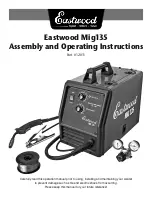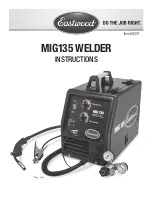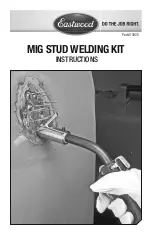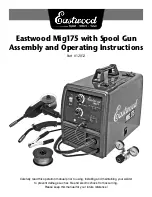
MAINTENANCE
/
REP
AIR
TROUBLESHOOTING
OPERA
TION
ASSEMBL
Y /
INST
ALLA
TION
SAFETY /
SPECIFICA
TIONS
GETTING ST
AR
TED
9
8. Turn on welder and set wire speed to 10. Activate torch trigger until wire feeds out past the torch end.
Turn welder off.
9. Carefully slip contact tip over wire, screw tip into torch end and reinstall nozzle (See Figure 3). Cut wire
off approximately 1/4 inch from nozzle end.
Duty Cycle / Thermostatic Protection
Welder duty cycle is the percentage of actual weld time that can occur in a ten minute interval. For
example, at a 20% duty cycle, actual welding can occur for two minutes, then the welder must cool for
eight minutes.
Internal components of this welder are protected from overheating with an automatic thermal switch.
An
amber lamp is illuminated on the front panel if the duty cycle is exceeded. Do not switch unit off. T
his will
allow the internal fan to cool the unit quickly. Welding operations may continue when the amber lamp is
no longer illuminated.
Polarity
MIG welding
wire requires the electrode to be positive.
Flux welding
wire requires the electrode to be negative. Always use the polarity recommended by the
welding wire manufacturer. The welder is factory set for flux welding wire.
TO CHANGE POLARITY (SEE FIGURE 4)
1. Unplug power cord from socket.
2. Open wire feed compartment door.
3. Remove two nuts from polarity studs.
4. Connect cable from drive deck to positive
stud and cable from work clamp to
negative stud for electrode positive
polarity for MIG welding. Connect cable
from drive deck to negative stud and
cable from work clamp to positive stud
for electrode negative polarity for flux
core welding.
5. Reinstall two nuts and tighten securely.
If the nuts are not
tightened
properly,
excessive heat will be generated by the loose
connection and the insulators on the studs will be
damaged.
Shielding Gas Preparation
Improper handling and maintenance of compressed gas cylinders and regulators can result in
serious injury or death! Always secure gas cylinders to a wall or other fixed support to prevent
cylinder from falling over. Read, understand and follow all compressed gas and equipment warnings in the safety
instructions.
NOTE:
Shielding gas is not required if flux-core welding wire is used.
GAS TYPES
There are 3 types of gas generally used for gas metal arc welding; 100% argon, a mixture of 75% argon and
25% carbon dioxide (C25) or 100% carbon dioxide.
Use ONLY the type of gas recommended for your welder. Use ONLY an inert, non-flammable
type of gas. Failure to do so will result in a very hazardous situation.
The 75/25 mixture is recommended for general steel welding. For aluminum welding, use 100% argon.
Cylinders of either type gas may be obtained at your local welding supply outlet. Secure cylinder to prevent
it from falling over.
Figure 4 - Polarity control
NOTE:
Electrode negative
polarity (typical for flux
core welding) shown in
figure.
Reverse cables for
electrode positive polarity
(typical for MIG welding).
Positive stud
Negative stud
Brass nuts
Ground cable
Drive deck
cable












































